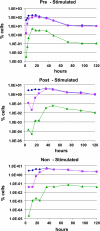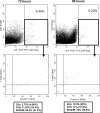Immediate activation fails to rescue efficient human immunodeficiency virus replication in quiescent CD4+ T cells
- PMID: 17229711
- PMCID: PMC1866069
- DOI: 10.1128/JVI.02569-06
Immediate activation fails to rescue efficient human immunodeficiency virus replication in quiescent CD4+ T cells
Abstract
Unlike activated T cells, quiescent CD4+ T cells have shown resistance to human immunodeficiency virus (HIV) infection due to a block in the early events of the viral life cycle. To further investigate the nature of this block, we infected quiescent CD4+ T cells with HIV-1(NL4-3) and immediately stimulated them. Compared to activated (prestimulated) cells, these poststimulated cells showed slightly decreased viral entry and delays in the completion of reverse transcription. However, the relative efficiency of integration was similar to that of prestimulated cells. Together, this resulted in decreased expression of tat/rev mRNA and synthesis of viral protein. Furthermore, based on cell cycle staining and BrdU incorporation, poststimulated cells expressing viral protein failed to initiate a second round of their cell cycle, independently of Vpr-mediated arrest. Together, these data demonstrate that the early stages of the HIV life cycle are inefficient in these poststimulated cells and that efficient replication cannot be induced by subsequent activation.
Figures







References
-
- Brooks, D. G., D. H. Hamer, P. A. Arlen, L. Gao, G. Bristol, C. M. Kitchen, E. A. Berger, and J. A. Zack. 2003. Molecular characterization, reactivation, and depletion of latent HIV. Immunity 19:413-423. - PubMed
-
- Chiu, Y. L., V. B. Soros, J. F. Kreisberg, K. Stopak, W. Yonemoto, and W. C. Greene. 2005. Cellular APOBEC3G restricts HIV-1 infection in resting CD4+ T cells. Nature 435:108-114. - PubMed
Publication types
MeSH terms
Substances
Grants and funding
LinkOut - more resources
Full Text Sources
Research Materials

